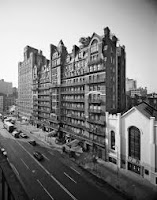
I was on BBC Radio 4's Front Row Friday night, discussing the auction of doors salvaged from the renovation of the Chelsea Hotel, bought by a property company and being turned into, well, part of whatever most of Manhattan has been turned into today. You can link to the programme on the
IPlayer here; it's the second item, about 15 minutes in, and sadly was rushed for time for a subject that has so much popular culture currency. But we probably should have concentrated primarily on the relative value-ranking of the sold doors.
Setting the scene was taking too long, so I never got a chance to get to the most crucial character in the story, Stanley Bard, who ran the place from the Seventies onward. This was probably my fault, as I am fascinated by its origins: the architect Philip Hubert virtually invented the concept of a 'coop', and built the Chelsea (in 1884 not 1885) to house both artisans and artists, the upper floors having studios while many apartments were allocated to people who'd worked on the construction.

The twelve story building was not, as is widely reported, the tallest building in New York when it opened; it was however the tallest without a spire (Trinity Church, at 279', was almost twice as tall). But by 1890, when structural steel took over in building, as it had in Chicago, Pulitzer's World building, 20 stories and 348 feet, took the mantle.
Hubert's vision didn't work out financially, and new owners included the very rich, and one of the mainstays of the Chelsea would always been its attraction to what someone called 'the troubled children of the very rich'. When the hotel had more financial problems during the Depression, it was bought by three partners, one of whom was Stanley Bard's father, and eventually Stanley took over as manager. He was finally forced out when the heirs of the other two partners decided to sell the hotel, which finally happened in 2007.

Bard would have been a better starting place; I should have begun with the idea that there was never a house dick at
the Chelsea in its glory days. Stanley let people do what they wanted,
as long as they weren't 'destructive to the hotel'. That didn't apply to
Edie Sedgwick, who famously fell asleep and set her room on fire; Bard
moved her to the first floor, where the lobby staff could keep an eye on
the room, and protect the art, often accepted in lieu of rent, that decorated the walls.
We did touch briefly on the way the Chelsea remained a melting point for bohemian artists and what we might today call 'trustafarians'. It's first peak was probably in the Fifties, when New York was the cultural capital of the world, and lots
of the people who made it so were at the Chelsea, the beat writers, the
abstract expressionist painters (Mark Rothko paid his rent with
paintings).

Arthur Miller wound up there in 1961 after his divorce
from Marilyn Monroe, before moving to his farmhouse in Roxbury,
Connecticut. That's him with writing with Elia Kazan looking on, in his tidy room. Miller described the hotel as having 'no vacuum cleaners, no rules, no shame'. We mentioned Dylan Thomas, who didn't actually die in the
hotel, nor actually drink himself to death at the White Horse, but the fact he was staying there was enough. Most of the Beats stayed at some point, though William Burroughs didn't write
Naked Lunch there. Jack Kerouac's door went for $30,000.

In the Sixties Andy Warhol's crowd and musicians made the Chelsea. Warhol's film
Chelsea Girls is more remembered than watched nowadays, while Shirley Clarke's
Portrait Of Jason
may get the actual feel of the place in the Sixties the best; Clarke
was a resident there. Oddly,
Chelsea Girls doesn't include Warhol's
superstar, Viva, who was a long-term resident. Bard's efforts to get her
to pay rent were legendary, cornering her in the slow lift, or yelling at her in lobby, but they only once wound up in court (her rent,
legally controlled, was $920 a month). Once when the people in the flat
next door moved out, Viva knocked a hole in the wall and doubled the
size of her apartment. If you remember her film performances, you might
imagine her righteous indignation. My favourite Chelsea Hotel photo is
probably Viva and Patti Smith standing on one of the beautiful
wrought-iron balconies, or maybe the one with singer Eric Andersen tied up with
them there.

Smith and Sam Shepard lived there, in a room slightly less neat than Arthur Miller's. Which reminds me, when you hear Viva talking about the
suicides at the hotel, like her upstairs neighbour who landed head-first
on a table in the courtyard, you get a real sense of ho-hum, don't you
wish you could watch your neighbours do that, about her. Talk about neatness.
The highest price paid for a door was $100,000, for room 211, where Bob
Dylan wrote 'Sara'. I wonder if Dylan was staying there because the
Chelsea was where Harry Smith lived (and died). Smith's Anthology Of
America Folk Music was a bible of sorts for Dylan; listen to The
Basement Tapes if you don't believe me. And of course Leonard Cohen's (424).
That door went for $85,000. Host Stig Abel opened the show by playing a clip of Cohen's 'Chelsea Hotel 2', but spared the post-Archers audience the best line: 'giving me head on the unmade bed while the limousines wait in the street', which sums up what the hotel quickly became and may be the greatest rock/sex line ever. Janis Joplin, who was giving the head, and making an exception for the less-than-beautiful Cohen,was in room 411. Jimi Hendrix stayed in room 430; his door drew only $13,000.

After that the decline began. Rich rock stars took rooms, tourists flocked to see them. After Sid Vicious killed Nancy Spungen, in the bathroom of room 100, Bard divided the room into two
to stop tourists making a gawk shrine of it. There's a great picture of the
two of them in the bathroom. What I love
about it are the toothbrushes neatly lined up in the holder on the wall. Alex Cox's
Sid And Nancy is probably the best of the movies set there; it's also one of funniest films of the 80s. Much more telling than Madonna's book
Sex, which was the end of the line for the old Chelsea, being sold for celebrity, the entire hotel treated like the discarded doors would be 30 years later. In its later years stars like Rufus Wainwright would check in for a year and then release a record written in the Chelsea, as if they could appropriate a sense of artistic suffering and struggle by footing the bill for its artistic rub.
Stig also mentioned Arthur C Clarke writing
2001 there. It was actually the screenplay for the film he wrote there, with Stanley Kubrick also staying: according to Barry Miles, Clarke kept a telescope in his room, and used it to look into windows. Those were the kind of stories I wanted to bring in; a painter named Alphaeous Phileomon Cole lived in the hotel for 35 years and died in 1988 at the age of 112; he was supposedly the oldest living man on earth at the time. Or the masochistic heiress Isabella Stewart Gardiner picking up fellow drunks to beat and rob her. Of Julian Schnabel's daughter doing her college homework in the bar of the El Quijote restaurant in the hotel lobby. Charles Jackson, who wrote
The Lost Weekend, killed himself in the Chelsea in 1968.

I was fascinated by the families who lived there. I didn't mention the novelist Joseph O'Neill, who lived there with his wife and three children. I did mention the composer Virgil Thompson, a long-term resident, whose flat 920 was bought after his death, and kept in period features by the couple who bought it. You can find pictures of it online, and it gives you a sense of the grace of those upper floors. It also made me think of the couple who bought it, also with three kids, sending them out trick or treating on Halloween up and down the Chelsea.

At the end of the item Stig
asked me whose door I would choose he opened it up to anyone in
history--trying to reduce my choices I fell on Kerouac, as I'd been
trying to figure out how to get his one-night stand with Gore Vidal at
the Chelsea into the conversation. I should have said Rothko, far more of an artistic idol for me, and the
first thing I would have done would be look for paint drippings. When I called the Gramercy Hotel 'just around the corner and down the street' I was speaking figuratively: I wanted to get in the idea Beat and Warhol crew member Gerard Malanga always used to put his friends into the East Side hotel: when I finally had some money I stayed there too: you got a key to Gramercy Park, one of the nicest squares in New York, and it was two blocks from Pete's Tavern. Charles Ives lived off Gramercy Park; I liked the contrast with Virgil Thompson in the Chelsea.
Looking at what I've just written, it's no surprise I felt I hadn't done the best presentation: there is just too much. But I was hoping for Stig to ask if the passing of the old Chelsea was the end of an era. Being me, I managed anyway to squeeze in these lines, which I did not read well as I was rushing to get the item finished quickly. They're from a poem called The Hotel Chelsea:
Anita! Soon this Chelsea Hotel
Will vanish before the city's merchant greed.
Wreckers will wreck it and in its stead
More lofty walls will swell
The old street's populace. Then who will know
About the ancient grandeur, marble stairs,
Its paintings, onyx-mantels, courts; the heirs
Of a time now long ago.
It was written by Edgar Lee Masters. In 1936. As former Chelsea Hotel resident Robert Crumb said: "It's always the end of some era in New York".






















